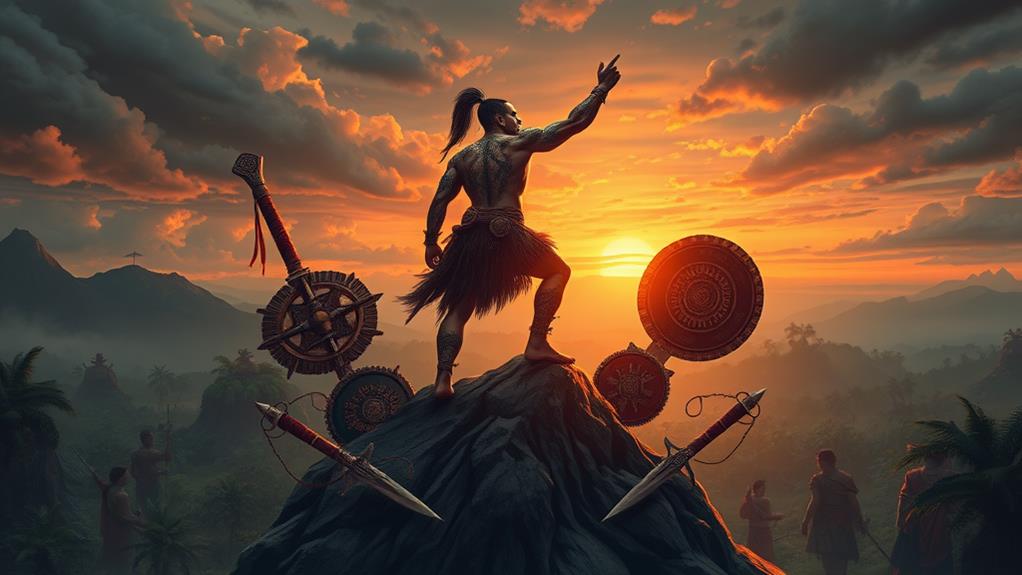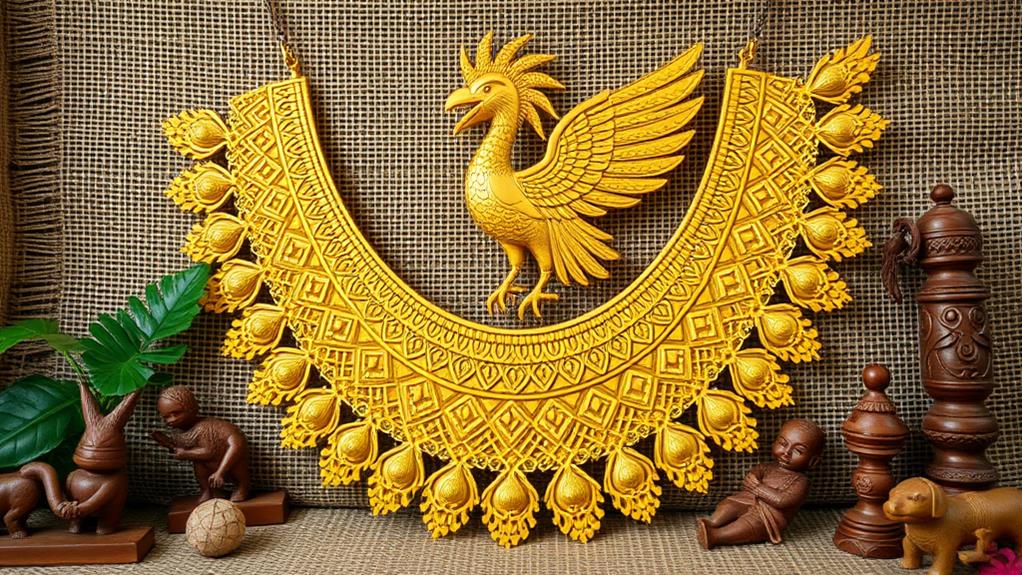The Pre-Colonial Philippines was a complex and dynamic world where advanced agricultural practices, sophisticated martial arts, and extensive maritime trade networks thrived for centuries.
Early settlers introduced agricultural practices, which allowed them to grow crops such as rice, corn, and sugarcane. These practices led to the development of barangays, which were organized communities led by a datu. The datu was responsible for resolving disputes, collecting taxes, and performing rituals.
The social structure of the pre-colonial Philippines featured distinct classes, including the datu, nobles, freemen, and slaves. The introduction of Islam led to the establishment of sultanates, which integrated Islamic law into their governance.
Unique traditions and beliefs shaped the pre-colonial Philippines, influenced by indigenous animism and cultural exchanges with traders from China, India, and Southeast Asia.
For example, the Ifugao people built elaborate rice terraces, while the Tausug people developed a complex system of astrology.
Ancient Societies and Cultures
Ancient Societies and Cultures of the Philippines
The early settlers of the Philippines, including Negritos and Austronesians, introduced advanced agricultural practices that transformed the island's landscape. These early settlers brought with them knowledge of irrigation systems and rice cultivation, which allowed them to thrive in their new environment.
The early settlers organized themselves into barangays, village communities led by a datu who served as both political and religious leaders. The datu was responsible for resolving disputes, collecting taxes, and performing religious rituals.
The social structure of the barangay featured distinct classes, with a ruling elite and commoners, influenced by kinship ties and external cultural interactions through trade networks.
The introduction of Islam in the 13th century led to the establishment of sultanates, which centralized governance and integrated Islamic law into local customs. The sultanates were ruled by sultans, who held significant power and authority.
Indigenous animism and cultural influences from Chinese, Indian, and Malay traders also shaped the pre-colonial heritage. These diverse cultural influences resulted in a unique blend of traditions, practices, and beliefs that defined the Philippines' ancient societies and cultures.
Economic and Agricultural Practices
The Philippines' agricultural landscape transformed significantly by the 13th century. Early settlers introduced advanced farming practices that enabled sustainable food production. One such practice was swidden agriculture, where plots were rotated to allow soil recovery and prevent depletion. This method ensured soil fertility and prevented erosion.
Staple crops were cultivated, including rice, millet, bananas, and root crops. Root crops were the most common due to their adaptability to various soil types and climates. The Ifugao rice terraces, built around 1650 CE, showcased advanced agricultural techniques adapted to the mountainous terrain. These terraces demonstrate the ingenuity and resourcefulness of pre-colonial Filipinos in harnessing their environment.
Maritime trade routes facilitated the exchange of goods like rice, cotton, and abaca with neighboring regions. This exchange contributed to the economic development of pre-colonial societies.
The growth of trade networks stimulated economic development and cultural exchange. Through their agricultural practices, pre-colonial Filipinos were able to sustain themselves, trading excess goods and fostering economic growth.
Martial Arts and Warfare Traditions

Pre-colonial Filipino warriors developed unique martial arts skills that emphasized weapon-based combat. These martial arts featured distinct weapons, such as the balaraw, a dagger typically measuring 20-25 cm long.
Two primary swords, the kris and kampilan, were staples in pre-colonial combat. The kris, renowned for its fine tempering and layered steel construction, symbolizes Filipino martial culture. The quality of the kris varied across different regions, reflecting local traditions and techniques.
The kampilan, on the other hand, was characterized by a long, straight blade often coated with poison for lethality.
Ancient Filipino warriors showcased ingenuity and resourcefulness through the use of padded armor and carabao-hide breastplates for protection during warfare.
The frequent application of poison to weapons added a psychological element to conflicts, enhancing their perceived lethality.
These martial arts and warfare traditions demonstrate the sophistication and complexity of pre-colonial Filipino societies.
Maritime Trade and International Relations
The pre-colonial Philippines was a significant player in Southeast Asian maritime trade, with connections spanning as far as Japan and the Maldives, centuries before Spanish colonization.
Advanced navigational skills enabled long-range maritime trade, connecting the Philippines with distant regions. The Austronesian ancestry of the Filipino people rooted these skills, allowing them to navigate the seas with precision.
The Philippines maintained tribute and trade relations with neighboring cultures, as documented by Antonio Pigafetta. These interactions highlight the significance of tribute and trade in shaping international relations. For instance, the Philippines exchanged goods with China, Japan, and Southeast Asian kingdoms, fostering diplomatic relationships and cultural exchange.
Philippine maritime vessels, such as the karakao and praos, played a crucial role in both trade and warfare. Their unique designs demonstrated the Philippines' expertise in maritime technology. These vessels facilitated the transportation of goods, people, and ideas across the region.
Cultural exchange and enrichment occurred through extensive interactions with various cultures, including Indians, Arabs, and Malaysians. The exchange of goods, cultural practices, and technologies enriched the Philippines' socio-economic landscape.
For example, the introduction of Islam and Buddhism from India and Southeast Asia influenced the Philippines' religious and cultural practices.
These factors collectively underscore the Philippines' importance in ancient Southeast Asian maritime trade and international relations, showcasing a sophisticated and connected society that thrived long before Spanish colonization.
How did Ancient Filipino Societies interact with the Natural Landscape of the Philippines?
Ancient Filipino societies had a deep connection with the natural wonders of the philippines. They integrated their lifestyles with the rich biodiversity, using the land for agriculture and trade. The natural landscape influenced their beliefs and rituals, leading to a harmonious coexistence with the environment.
Art, Textiles, and Material Innovations

Ancient Filipinos' Craft Innovations Demonstrated Sustainability and Cultural Significance
The ancient Philippines' artisans showcased a deep understanding of sustainable production methods and cultural significance in their creations.
The Banton Cloth, the oldest warp ikat textile in Southeast Asia, demonstrates advanced weaving techniques, showcasing sophisticated craftsmanship.
Pottery Reveals Artistic Skills and Functional Designs
Archaeological findings at Ayub Cave highlight the artistic skills and functional designs of ancient Filipinos.
Their pottery showcases a deep understanding of form and function, reflecting a sophisticated understanding of design principles.
Indigenous Jewelry Featured Intricate Designs and Sustainably Sourced Materials
Indigenous jewelry from the pre-colonial period features materials like carnelian, agate, and pearls, with intricate designs that reflect complex social and aesthetic values.
These designs not only demonstrate craftsmanship but also a commitment to sustainability and cultural significance.
Culinary Arts Reflected Sustainable Practices and Medicinal Understanding
The culinary arts of ancient Filipinos were characterized by sustainably sourced ingredients, reflecting a deep connection to the land and a sophisticated understanding of medicinal practices.
These innovations demonstrate ancient Filipinos' commitment to sustainability and cultural significance in their daily practices.
Questions and Answers
What Was the Pre Colonial Society in the Philippines?
The pre-colonial society in the Philippines was a complex, multifaceted culture characterized by a mix of political, economic, spiritual, and social structures.
Politically, the society was organized into barangays, small settlements led by a datu, a chief or leader. These barangays were often independent and self-governing, with the datu making decisions for the community.
Economically, the people practiced advanced agricultural practices, such as rice cultivation and irrigation. They also engaged in trade networks that connected them to other regions, including China and India.
Spiritually, the people believed in a complex pantheon of gods and goddesses, and shamans played a significant role in their spiritual lives. Shamans were believed to have healing powers and the ability to communicate with the spirits.
Socially, the people lived in a hierarchical society, with the datu and other nobles at the top, followed by the freemen, and then the slaves.
The society was also marked by vibrant artistic expressions, such as weaving, pottery, and woodcarving, which showcased the rich cultural heritage of the diverse ethnic groups.
What Was the Philippines Like Pre Colonization?
The Philippines was a land of diverse societies, each with their own distinct culture and social hierarchy, before colonization.
Advanced agricultural practices were present, with rice, sugarcane, and coconut being staple crops. These crops were cultivated using irrigation systems, which allowed for efficient farming and surplus production.
Trade flourished with neighboring regions, including China and Southeast Asia. This exchange of goods resulted in the introduction of new technologies, ideas, and cultural practices.
Spirituality was deeply rooted in animism, with shamans playing a vital role in the spiritual and social lives of the people. Shamans were believed to possess healing powers and communication with spirits, giving them significant influence in the community.
Intricate arts and rich oral traditions were an integral part of the Filipino culture, with wood carvings, weaving, and pottery being notable examples. These art forms were used to express cultural values, myths, and legends.
Complex political systems existed, with barangays (villages) being the basic unit of governance. Each barangay was led by a datu (chief), who was responsible for maintaining order, resolving disputes, and collecting taxes.
These aspects of pre-colonial Philippines society shaped the country's identity and cultural heritage, which continue to influence modern Filipino culture.
What Was the Philippines Society Before the Coming of the Colonizers?
The Philippines' pre-colonial society was organized into small village communities called barangays. Each barangay was led by a datu, who held both political and religious authority. For instance, the datu made decisions for the community, resolved disputes, and performed religious rituals.
Early inhabitants of the Philippines introduced advanced agricultural practices, transitioning from a hunter-gatherer lifestyle to settled farming. They developed techniques such as irrigation and crop rotation, which allowed for more efficient food production. This shift enabled the growth of more complex societies and the development of trade networks.
Trade networks flourished in the Philippines, connecting the archipelago with other regions. The people of the Philippines traded goods such as rice, salt, and textiles with neighboring countries, including China and Indonesia. This exchange of goods helped to establish strong economic ties between the Philippines and other nations.
Spiritual beliefs in the Philippines were predominantly animistic, meaning that people believed that natural objects and phenomena possessed spirits.
Shamans played a crucial role in these beliefs, serving as spiritual leaders and healers. They communicated with the spirits, performed rituals, and provided guidance to the community.
What Were the Characteristics of the Pre Colonial Period in the Philippines?
The pre-colonial period in the Philippines was characterized by a diverse range of ethnic groups. These groups, descended from Austronesian migrants, each had their own languages and customs. For example, the Tagalogs, Visayans, and Kapampangans were some of the major ethnic groups that inhabited the islands.
Social structures were organized into barangays. Each barangay was led by a datu, who held significant power and influence over the community.
Kinship played a key role in these social structures, with families and clans forming the basis of social organization.
Economically, the pre-colonial Filipinos relied on subsistence farming and trading networks. They grew crops such as rice, corn, and sugarcane, and traded goods with neighboring countries like China, India, and Southeast Asia.
Spiritually, animism was central to the pre-colonial Filipinos' beliefs. They believed that spirits inhabited natural objects and phenomena, and shamans played a vital role in communicating with these spirits.
Influences from Hinduism, Buddhism, and Islam also added to the cultural landscape, particularly in the southern regions of the Philippines.